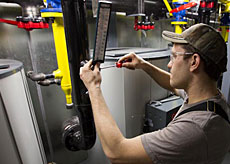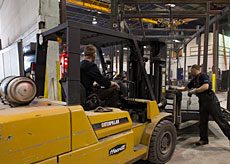
True cost of ownership can be deceiving.
As you compare data center pricing for the various approaches to new data center construction, be sure to factor in the hidden costs associated with traditional construction that are eliminated in off-site, factory-built custom data center solutions, as well as the long-term cost of living with less-than-desirable options you inherit with cookie-cutter, containerized modular data centers.
The concept of the Data Centers Delivered turnkey data center system is to save money and reduce schedule. Money is saved through hard costs, soft costs, and risk mitigation.
Hard costs:
Hard costs include the easily quantifiable expenditures such as data center equipment, enclosure, engineering, and items that have an associated invoice.
Data Centers Delivered offers a complete system that includes both data center products and services, but the majority of the cost is associated with what is considered as equipment. The data center itself is a custom engineered product. The equipment and labor required to assemble the package are all rolled up into a fixed, or hard, cost.
Soft Costs:
Field:
 Traditional field construction has a mixture of equipment and labor. Labor is typically purchased though a contract, while equipment is purchased through purchase orders. Purchase orders carry terms and conditions that are different from contractual agreements.
Traditional field construction has a mixture of equipment and labor. Labor is typically purchased though a contract, while equipment is purchased through purchase orders. Purchase orders carry terms and conditions that are different from contractual agreements.- Labor contracts are negotiated to help mitigate risks, however, the risk is still very real as there are other outside factors such as availability of skilled labor, labor shortages, and local jurisdiction labor laws, which are all very common and realistic challenges. All of these issues can cost the data center owner money, without having received a single product.
- Purchase orders — the method Data Centers Delivered works under — have different terms where the supplier actually holds more risk than the customer throughout the construction process. Since the bulk of payment is not due until the product is delivered, there is minimal risk to the data center owner and no requirement for bonding.
- Contracts use a progressive billing system, whereby the construction management team submits time cards and equipment invoices for payment from the customer on a monthly basis. This causes the owner to make financial commitments earlier and start accruing potential interest earlier in the project as the balance increases throughout the project.
- Purchase orders have more flexible payment terms, allowing the customer to hold onto their money longer.
- Field labor is subject to weather conditions and site limitations such as access to elevated levels, on-site safety training, parking, facilities, dedicated work areas and times. All of these potential issues will cost time and money.
- Off-site construction takes place inside a controlled environment with easy use of material handling (overhead cranes, tow motors, etc). This eliminates risk of delays due to weather and site-specific issues.
- Coordination of trades: Field construction is subject to sequential processes, where one task must be completed before another one can start (i.e. the building needs to be completed before the equipment can be installed). Sequential processes across multiple trades requires detailed scheduling and synchronization. To that end, the owner must have an additional level of management to ensure time is not being lost.
- Off-site data center construction allows for multiple tasks to be completed in parallel, coupled with the fact that there are fewer people to deal with on site. The data center owner can realize savings by streamlining the construction management of the project.
- Testing and commissioning is a very important part of the process that the data center owner is normally very close to. Field construction does not allow this process to start until everything is installed. Due to an array of potential inconsistencies between engineered drawings and the final system, the commissioning and test procedures are very lengthy – and billable-time consuming — processes.
- Data Centers Delivered builds the off-site data center system from fabricated drawings where the end product is exactly as is shown on the drawings. The complete system is assembled in the plant before shipping to the site, allowing for factory testing and pre-functional commissioning to be completed in the factory under a controlled environment. This saves the data center owner time (and money) and reduces risk of potential system issues that would not be identified until later in the process under field construction. Fixing or altering the system is much easier and cheaper to complete inside the factory than out in the field.
- Since data centers are typically built in phases, the field option forces the data center owner to invest in infrastructure in phase one that may not be required until the future. The contractor will need to build the building shell in phase one, but only fit out a portion of that building. Off-site data center construction allows scalability because we only fabricate and ship – and the owner only pays for — what is required now.
Risk Mitigation:
 Risk equals money, and the addition of soft costs — line items that are either rolled up into a broader cost center or are captured in a general expense — include management time, coordination issues, delays, and any other inconvenience that comes with field construction.
Risk equals money, and the addition of soft costs — line items that are either rolled up into a broader cost center or are captured in a general expense — include management time, coordination issues, delays, and any other inconvenience that comes with field construction.
Purchasing gear carries a minimum risk and contractors apply a minimal mark-up on gear. Their mark-up is to cover the paperwork, handling, profit and short-term financing. Equipment is specified, pre-qualified and most often repeatable. The product is purchased and is delivered to the building site. The risk is associated with delivery delays and incorrect or faulty gear (all of which is mitigated through the specification process).
Purchasing a scope of work or labor comes with much more risk, and therefore the associated mark-up is much higher. Estimating labor hours to complete tasks is not an exact science and with so many dynamics at a construction site, labor costs can easily run far over the estimates. The more field labor involved with a project, the higher the risk and consequently higher the costs.
Hidden Costs of Containerization:
Containerized data center suppliers typically offer the IT/Compute solution in conjunction with the physical container. These suppliers are focused on the computing side of the business, leaving the mechanical and electrical infrastructure as a second thought. Once the data center containers arrive, there must be additional arrangements made to interconnect the containers and provide the mechanical and electrical support systems.
Some suppliers do offer mechanical and electrical solutions, but they are very limited in flexibility and often are not applied properly. With the total cost of ownership driven largely by pre-construction choices for data center cooling and energy efficiency, the hidden costs of containerized data centers can plague the organization for the life of the asset.